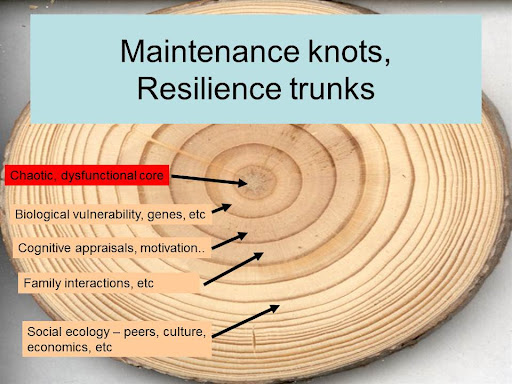5th June 2015
A focus on strengths and resiliencies is important in this work - particularly as building on these gives more scope for SUSTAINABLE changes.
This is an aspect of one of the Core Features of AMBIT, the stress on Scaffolding existing relationships:
Look at the AIM Form for prompts about areas of interest or skills (items are scored "0+" if they are particular strengths.)

Download a PDF version of this diagram here
The concentric rings around the core of a branch (that may be growing in an adaptive, or in a poorly adaptive direction) are what support it to keep growing in that direction:

This is an aspect of one of the Core Features of AMBIT, the stress on Scaffolding existing relationships:
- Identifying those moments in a young person's functioning that indicate a capacity to mentalize and a more compassionate relationship to their self (this is one of the key "legs" of The Therapist's Mentalizing Stance, which is Highlighting and reinforcing Positive Mentalizing.)
- Identifying the strengths in a young person's network can be challenging, but equally it is not uncommon to find that there are more strengths present than at first had seemed to be the case.
- In addition the young person may have particular skills or abilities that could be part of recognising and supporting Self-efficacy; re-engaging with these skills, or supporting a young person to find ways or places to use them and excel may have as much impact as any other therapeutic work. For instance supporting a footballer to re-engage with a local club, or for a musician to take up playing again... These are examples of Social-Ecological Work.
Look at the AIM Form for prompts about areas of interest or skills (items are scored "0+" if they are particular strengths.)
Examples:
- Sporting prowess
- Musical talent
- Membership of a local faith group
- Academic abilities
- Good relationship with an uncle/aunt/etc
- Prosocial friends - who may have drifted away but be "re-connectable".
- etc.
Resilience Trunks and Maintenance Knots
Most problems can be seen as "knots" emerging from "trunks" of resilience:Download a PDF version of this diagram here
The concentric rings around the core of a branch (that may be growing in an adaptive, or in a poorly adaptive direction) are what support it to keep growing in that direction: